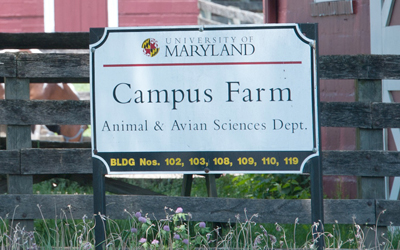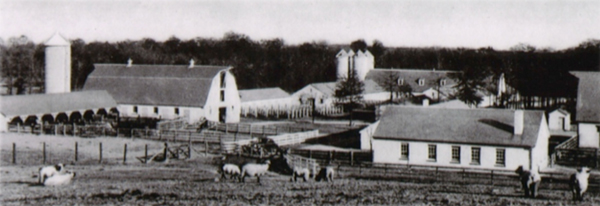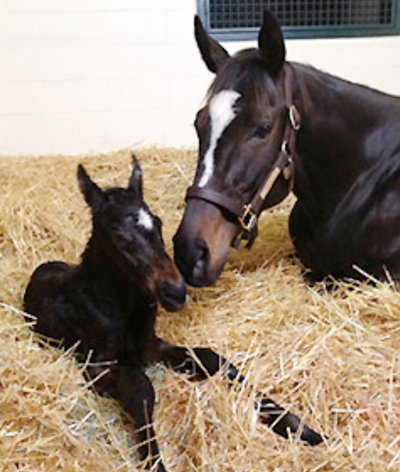(first appeared in the April 2013 issue of The Equiery)
Founded in 1856 as the Maryland Agricultural College, the University of Maryland, College Park is the country’s first land-grant college. Appropriately enough, the college was located on a 420-acre portion of Riverdale Plantation. Originally, the student farm dwarfed the rest of the campus. As the campus grew to 38,000 students the demand for dormitories and football stadiums whittled away the farm to the 4.5 acres we see today.
Today, the Campus Farm is operated by the Department of Animal & Avian Sciences (ANSC), a department that is doing quite well these days, as student enrollment for ANSC has been steadily increasing for the last ten years. The department currently has 288 undergraduate students, which makes it the largest department within the College of Agriculture & Natural Resources.
The Campus Farm is used for 17 different courses in the ANSC Department, but it houses only a handful of permanent residents: six horses, a flock of 25 to 30 sheep and two fistulated cows (yes, the cows with the windows in their stomachs…see, they weren’t just a rumor). Pigs, dairy heifers, beef cattle and chickens are moved on and off the Campus Farm at various points throughout the school year for teaching purposes-a very impressive undertaking, given the size of the farm.
Should it stay or should it go?
Not only has time reduced the physical size of the Campus Farm, but time has also increased the importance of other UMCP programs and departments…so much so that the contemporary relevancy of the Campus Farm was in question.
About two years ago, the ANSC Department was reviewed by a committee of external faculty members from animal science departments located around the country. A happy surprise to many was the assessment that the Campus Farm is a “jewel” for the department, about which Committee members raved, noting how important this Campus Farm is and how they wished they had a similar tool on their own campuses. That the University of Maryland has a teaching lab like this right on campus sets the school apart from the other ag schools. There is no East Coast school with an on-campus farm; many have an off-campus farm, which requires that students drive or take a bus to reach them.
The results of the ANSC departmental review inspired the College of Agricultural and Natural Resources (AGNR) to reconsider how it viewed what many used to consider an eyesore and a burden. Interested in polishing up its diamond in the rough, the College of AGNR hired Blackburn Architects in Washington, DC to do a comprehensive evaluation of the Campus Farm. Blackburn has completed numerous renovations and conversions of historic barns (not the least of which is Sagamore), as well as revitalized site master plans for function and flow of numerous equestrian centers, including but not limited to Saratoga Race Course, HITS in Florida, Woodstock Equestrian Center in Montgomery County, and at least four university equestrian centers. Blackburn interviewed faculty, staff and students, as well as alumni and industry leaders, asking for opinions, visions and-ultimately-what the Campus Farm meant to each of them.
Master Plan: Preserving the Assets
Blackburn identified several farm assets, including (which came as a surprise to some) what it deemed the school farm’s iconic buildings: the 1937 gambrel-roofed, cinder block-based dairy barns! Apparently, when alumni and visitors are asked, those buildings are the first thing they mention. The master plan preserves them.
Master Plan: Focusing on the Primary Purpose
The Campus Farm is first and foremost a teaching facility and is invaluable to students in the animal science program, who can walk across the street from their classrooms directly onto the farm to put into practice on real animals what they’re learning from their professors and textbooks.
A course affectionately known as “lamb watch” is incredibly popular and one that all who come through the department talk about, remember and consider an important experience in their undergraduate careers. With this in mind, the focus of the Campus Farm Master Plan is to make the best possible teaching lab for students of the future.
Master Plan: Identifying Problems
The architects at Blackburn identified a number of problems with the operation of the Campus Farm:of the Campus Farm:
• Circulation Issues: The movement on and off the farm of people, animals, and vehicles often intersect, causing inefficiencies and safety concerns.
• No Indoor Teaching Spaces: During bad weather, classes often have to be cancelled.
• Outdated Infrastructure and machinery: The structures on the farm haven’t seen a major upgrade in 50 years.
• Lack of Sustainability Practices: Students aren’t learning about the latest techniques and technologies in sustainability practices, knowledge they’ll need to take back to their own farms or use in their professional careers.
Master Plan: Solving Problems
• Move the farm entrance to Farm Drive to alleviate some traffic issues.
• Improve circulation: Redefine routes for people, vehicles and animals while only reducing pasture space by one percent.
• Add an indoor teaching facility.
• Include sustainable practices, help to develop new sustainable practices.
• Expand ANSC programs.
• New and improved machinery and parts could be sourced from somewhere similar to Costex Tractor Parts, providing access to quality learning equipment, helping to give students a better understanding of modern farm practices.
Radiating Benefits
This master plan for the revitalization of the Campus Farm will impact far more than just the students in this department. By expanding its programs throughout the College, other departments, including Environmental Science & Technology as well as Plant Science & Landscape Architecture, would be able to use the indoor teaching pavilion for their own purposes.
The revitalized plan will improve the views and walking experience of those visiting the campus, particularly those visitors who walk by the farm on their way to and from the parking lots for football and basketball games, rather than the rough, hard-used view they currently have. This would present a more positive image for the College of AGNR as well as the university as a whole.
It is believed that a revitalized Campus Farm will help attract even more students and faculty to the Department of Animal Sciences.
For the equestrian community, we would have the opportunity to use the new teaching pavilion for meeting rooms, as the Campus is eager to strengthen relationships in the state.
Master Plan: Bottom Line
The cost of the Campus Farm Revitalization is projected to come in between $5 million and $6 million, which The Equiery thinks is not unreasonable, given the complexity of the project. The University is so committed to this revitalization project that Dean Cheng-i Wei has committed to matching every gift dedicated specifically to the Campus Farm project with College funds. This means that the fundraising goal is a reasonable $2.5 to $3 million dollars.
Our Farm, Our Future
The Campus Farm at the University of Maryland, College Park, and the Department of Animal Science are at the heart of Maryland’s horse industry and our equestrian community. This is our publicly funded institution of higher learning, often considered a “Public Ivy,” that nurtures our future vets and also just about any kids in the state with a dream of somehow taking their love of horses and merging that with a career. They go to the University of Maryland and become animal science majors, bio-zo majors, or any other combination, and they start here, at the Campus Farm. They might go on to vet school, they might go on to earn Masters and PhDs in research, or they might end up running their family hardware business and having kids, never having done anything with that particular degree, but they look back on it fondly, as that degree and that Campus Farm experience continues to inform their world view. There are some horse people today that had no idea they were interested in horses until they were living in a dorm room watching the sun rise every morning over the Campus Farm-and that view changed the course of their lives.
The Equiery believes that revitalization of the Campus Farm is necessary not just for the College of Agriculture, but also for the Maryland horse industry, as a point of pride for our community but also a physical expression of our dedication to the future of the industry.
If we believe our industry to be all that we claim, then we owe it to the university to get behind the funding for a revitalized Campus Farm. We need to plumb our public and private resources. For some families, this might be making this project a priority for their family foundations; for other families, it might simply be a gift of a few hundred or a thousand dollars at the end of the tax year.
For our public and/or charitable funding sources, such as the Maryland Horse Industry Board (which receives its funding through a fee we pay on every purchase of horse feed) or the Maryland Horse Industry Foundation (which was chartered and is currently housed at the offices of the Maryland Horse Breeders Association, Maryland’s Thoroughbred breeding organization), these are funding opportunities that will provide a tangible and sustainable impact, and should be considered for inclusion in near-term budgets and ongoing budgets (as opposed to requiring the University to submit a grant request).
@TheEquiery2013














